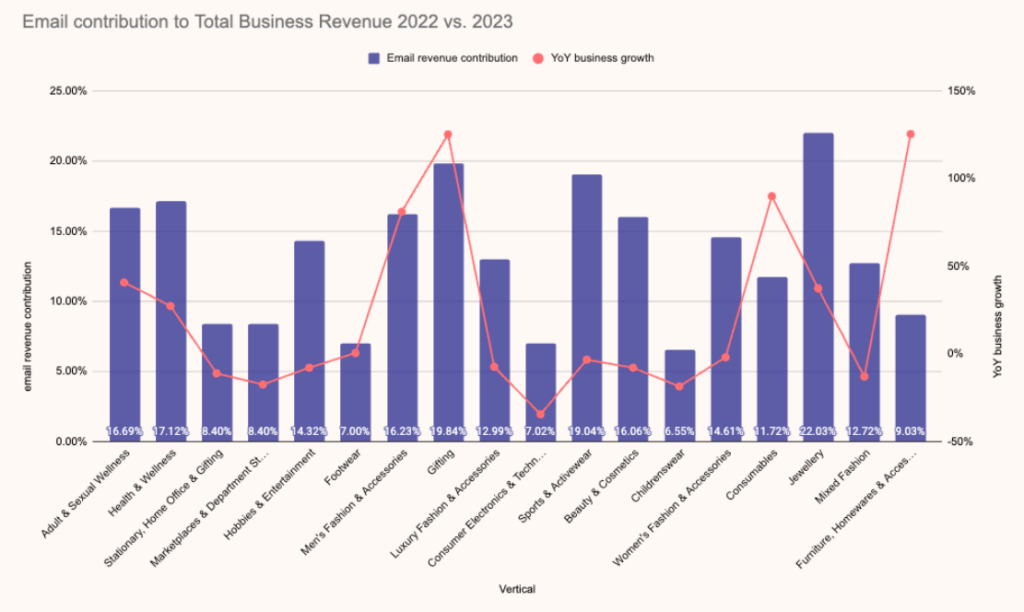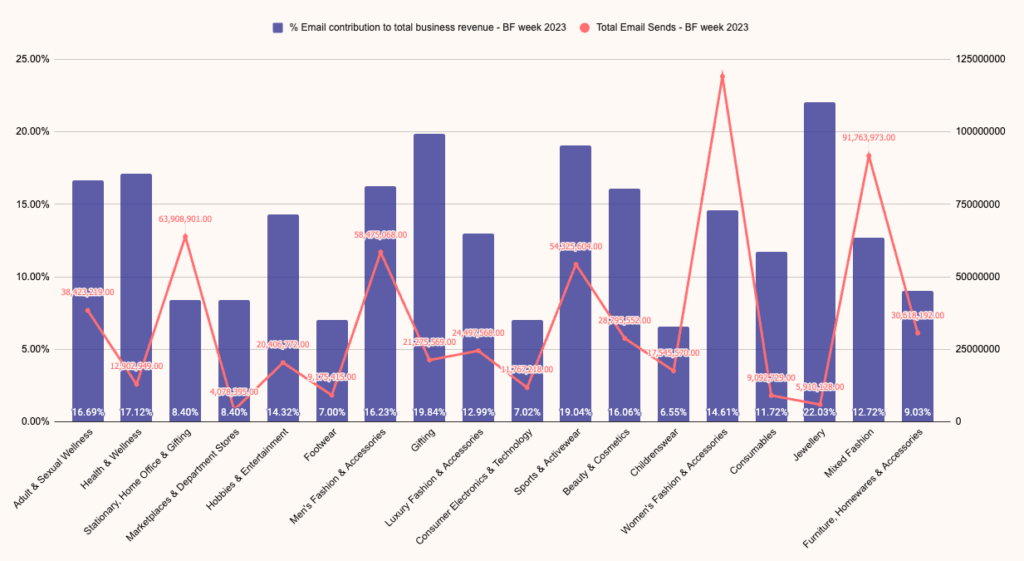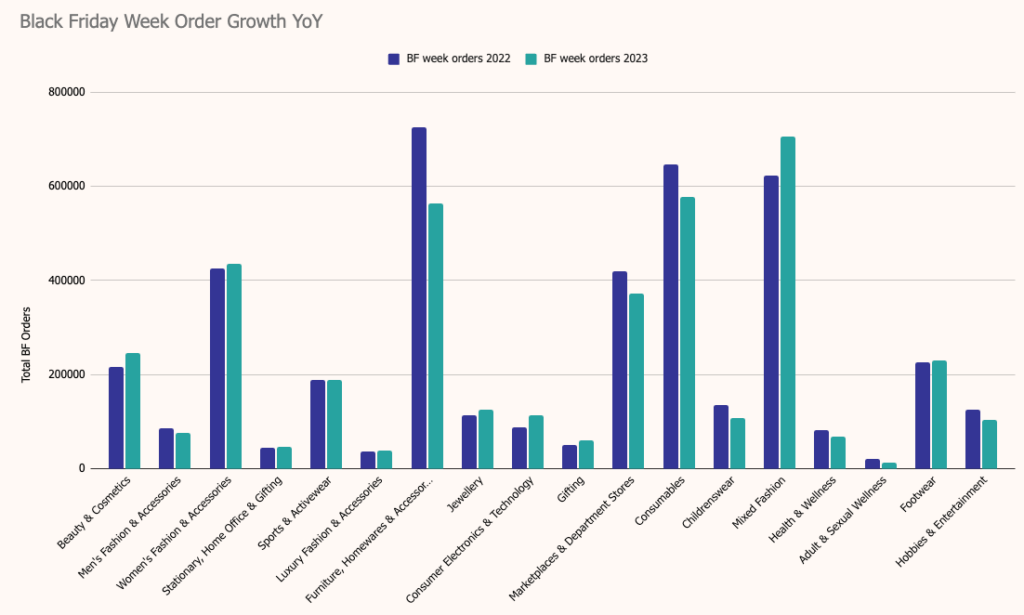Straight after BFCM, we reviewed the our favourite campaigns of Black Friday 2023, but now we’ve had a little time to crunch the numbers we wanted to spend time looking at what this data can tell us about the success of BFCM 2023, and see whether we can see any early trends retailers can learn from this holiday season. Before we take a look at verticalised revenue and order performance across BFCM week, let’s dig into some topline clicking patterns from this year, as they indicate some clear peaks in engagement worth noting for 2024.
In 2023, Ometria saw 40% of clicks occurring between 6-9 am on Black Friday, with 7-8 am being the busiest hour for sending. A later peak between 4-6 pm was also seen with 19% of clicks happening during these hours, a 3% increase on 2022.
Cyber Monday saw a slight shift in click patterns with fewer clicks happening during the morning peak, 28% in 2022 compared with 30% in 2021, however, the afternoon peak continued to grow in the early evening, with 27% of clicks happening between 4-8 pm.
Saturday saw a morning peak between 7-10 am (41.5% of clicks), with later spikes around 2-3 (6%) pm and 6-7 pm (7%). This lines up with understandable user behavior, with weekend mornings being the quietest point of the day for many, and the perfect time for browsing before weekend plans/ holiday plans start.
There are still clearly defined windows of time that are most effective for email engagement during BFCM, and while these fluctuate slightly year on year, and for the different days, they’re largely intuitive and the timings remain largely the same. This means that getting eyes on your email during those peak engagement times remains highly competitive, and adjusting the send time won’t necessarily deliver better engagement, and could prove risky. As a result, retailers still need to be focusing heavily on how they can stand out in the inbox, being creative with subject lines, and using customer data and buying behavior, abandoned browse data, or tailored product recommendations, to capture and maintain attention. Want examples of brands that nailed it this year? Our ‘Best of Black Friday’ blog is full of best-in-class retailer experiences.

Let’s get into our verticalised breakdowns. Starting with how email contributed to overall revenue performance here. As you would expect given the seasonality, both gifting and jewellery performed best from an email revenue contribution perspective, seeing an increase of 125% in year-on-year growth (gifting) and 37% (jewellery). Notably consumer electronics and technology saw a -37% decrease in growth this year, and also saw low revenue contribution from email. This is particularly interesting considering one of the consumer draws for BFCM originated with deep discounting on high-value electricals, and suggests either a shift away from this approach or that purchases like this might still be happening predominantly in-store.
At Ometria, our central belief is that more is not better when it comes to messaging, and that retailers need to focus on the quality of the experience of every engagement with their customers. It was encouraging to see that the numbers continue to validate this approach. Lower messaging was paired with higher email contribution to total business revenue this year in many verticals, including Beauty and Cosmetics, Health and Wellness and Gifting.

BFCM is an incredibly important time for retailer revenue, of course, but acquisition for the following year is also vital for ongoing positive performance. Most seasoned retail marketers know that BFCM acquisition and subscriber performance is a solid predictor of good revenue performance in the coming year. Many retailers doubled down on sign-ups from early October, communicating ‘subscriber-only’ early access to sales to help drive these numbers and reward loyal existing customers. Let’s take a look at 2023 subscriber growth, and how these numbers compared to 2022.

Interestingly stand-out areas for subscriber growth this year were largely in clothing, notably menswear and childrenswear. Understandably, luxury fashion and accessories saw low subscriber growth as this vertical doesn’t tend to participate in BFCM activities or discounting. Similarly the stationary/ home office category could have been impacted by more and more people returning to offices, or already having established home office set ups (three years post-pandemic), it’s not a vertical that closely aligns with the seasonality of BFCM (not many people are thinking much about their home office by the end of Nov), which could be why subscriber growth decreased this year.
Finally, let’s review those all-important order growth YoY. This view is really interesting, and shows very mixed results across verticals. In most categories, order growth looks flat or only slightly increased/decreased (with mixed fashion bucking the trend and showing significantly higher orders this year). Another noticeable deficit can be seen in Furniture/homeware & accessories, where orders are high over BFCM (indicating that consumers are still using this retail event to make big purchases) but 2022 orders were much higher than in 2023.

Hopefully BFCM has delivered an influx of new engaged customers, happy with their new purchases, and ready to be engaged with. What happens next is critical to securing that all-important repeat purchase and laying the foundations for lifelong consumer loyalty. Our post-BF checklist explores key strategies to drive newly acquired customer retention through Peak season and beyond. Download it now on our Black Friday Content Hub
Ometria is a Customer Data and Experience Platform exclusively for retailers, which means that, unlike other CDP/CDMP/ESP tech providers we are uniquely positioned to understand the retail challenges, use cases, and opportunities of retail events like BFCM. If your 2023 strategy didn’t quite hit the mark – why not speak to one of our team to understand how the retail experience and expertise of Ometria’s technology and team can help you to hit your goals now, next BFCM and beyond. Get in touch here
Ometria is committed to protecting and respecting your privacy, and we’ll only use your personal information to administer your account and to provide the products and services you requested from us. You may unsubscribe from these communications at any time. For information on how to unsubscribe, as well as our privacy practices and commitment to protecting your privacy, please review our Privacy Policy.
Take the first step toward smarter customer marketing